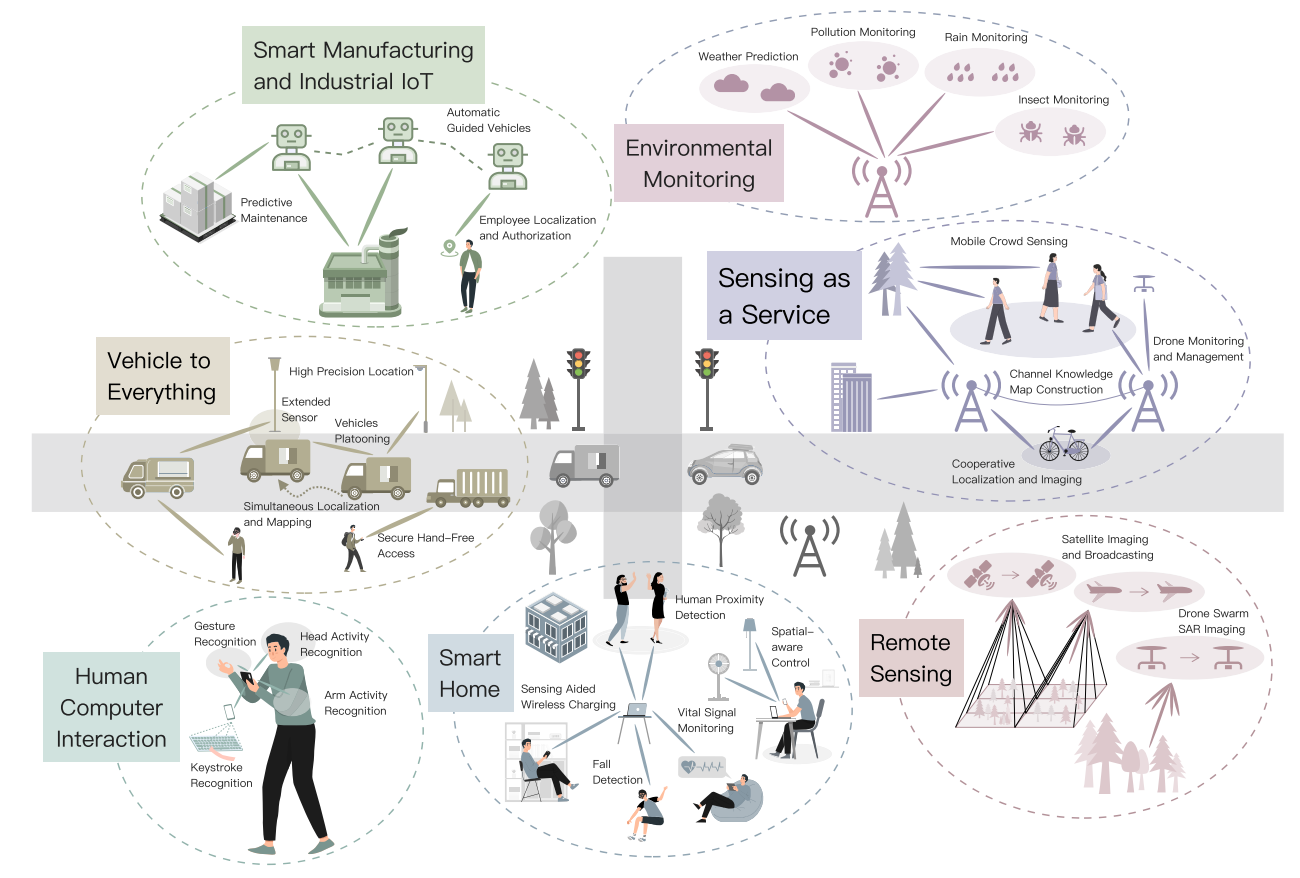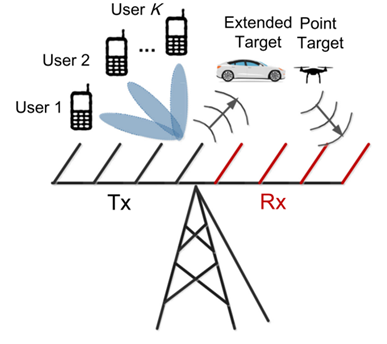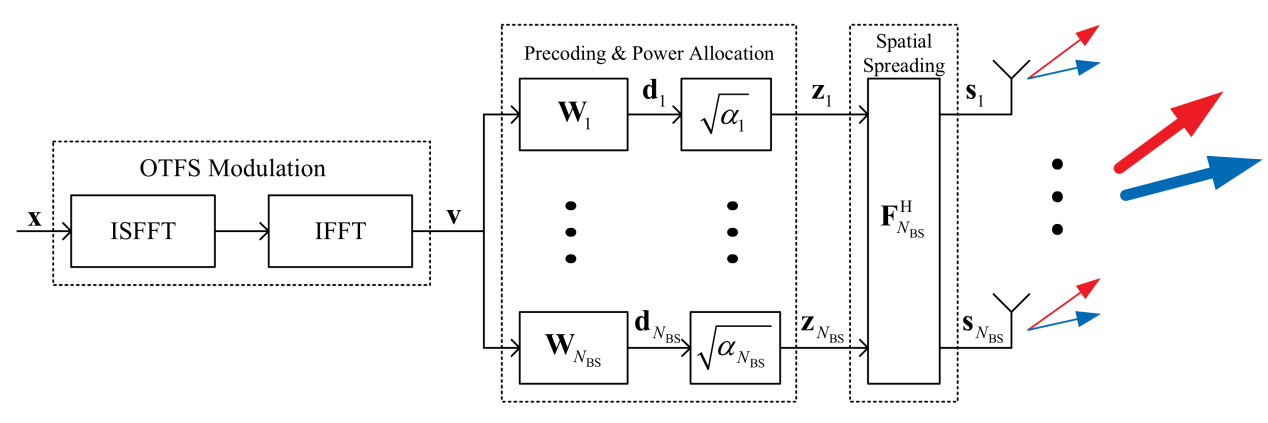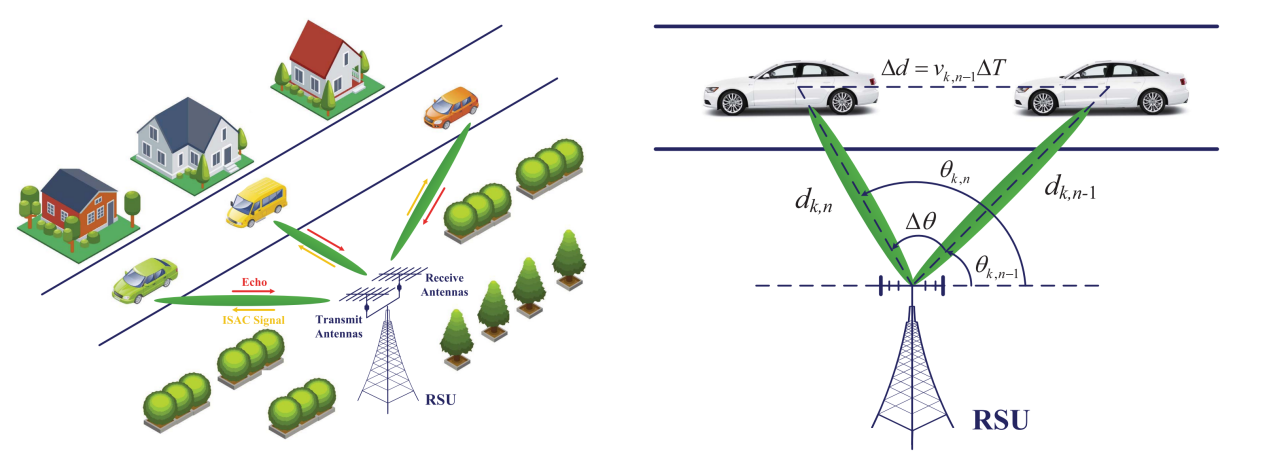Next-generation wireless networks (such as beyond 5G (B5G) and 6G) have been envisioned as key enablers for many emerging applications, such as smart cities, smart factories, intelligently connected vehicles, and telemedicine. These applications demand high-quality wireless connectivity, as well as highly accurate and reliable sensing capability. Therefore, Integrated Sensing and Communications (ISAC) has been widely recognized as a promising technology in the 6G network.
On the one hand, ISAC is expected to considerably improve spectral and energy efficiencies, while reducing both hardware and signaling costs as it attempts to merge sensing and communication into a single system, which previously competed over various types of resources. On the other hand, ISAC also pursues a deeper integration paradigm where the two functionalities are no longer viewed as separate end goals but are co-designed for mutual benefits, i.e., via communication-assisted sensing and sensing-assisted communication.

Figure 1. Application scenarios and use cases of 6G ISAC network
Assistant Professors Fan Liu and Weijie Yuan’s research group from the Department of Electronic and Electrical Engineering at the Southern University of Science and Technology (SUSTech) has recently made progress in the area of 6G ISAC. They have published five papers on their research results in top-tier wireless communications and signal processing journals, such as IEEE Journal on Selected Areas in Communications, IEEE Transactions on Signal Processing, and IEEE Transactions on Wireless Communications. In addition, multiple industry standardization proposals and white papers were produced.
Prof. Fan Liu was invited to publish a comprehensive technical review paper on ISAC, which involves multiple facets of ISAC, such as its historical development, technical background, use cases and standardization advances, information theory, signal processing, and network architecture. The paper received widespread attention and highly favorable comments from the research community.
The paper, entitled “Integrated Sensing and Communications: Toward Dual-Functional Wireless Networks for 6G and Beyond,” was published in IEEE Journal on Selected Areas in Communications, a top journal in the area of communications.
Prof. Fan Liu is the first author of this paper. Postdoctoral fellow Yuanhao Cui from the Beijing University of Posts and Telecommunications is the corresponding author. SUSTech is the first affiliation of the paper.
The core problem in ISAC is the design of a joint waveform, that is, to design a transmit waveform with dual functions that have both high-precision sensing and high-rate communications abilities. Conventional ISAC waveform design mostly adopts methods that approach some well-defined beampatterns or restrain the similarity of waveforms, which cannot directly improve the sensing metric of the system.
To that end, Prof. Fan Liu’s group proposed a base station side waveform optimization method for the scenario of multiple antennas with multiple users in a downlink ISAC system, guaranteeing the quality of communication service while minimizing the Cramér-Rao Bound of sensing, which is a non-convex problem. The research showed that the optimization problem has an optimal closed-form solution under the single-user scenario and possesses the property of hidden convexity under the multi-user scenario, which admits a globally optimal solution within polynomial time, thus, significantly improving the target angle estimation performance.
These research results, entitled “Cramér-Rao Bound Optimization for Joint Radar-Communication Beamforming,” were published in IEEE Transactions on Signal Processing, a top journal in signal processing.
Prof. Fan Liu is the first author of this paper. Assoc. Prof. Ya-Feng Liu from the Academy of Mathematics and Systems Science, Chinese Academy of Sciences, is the corresponding author. SUSTech is the first affiliation of the paper.

Figure 2. Multi antennas with multi users ISAC system
Another challenging problem in ISAC is how to analyze the performance of communications and sensing under a unified theoretical framework. To address this issue, the research group considered the design of the ISAC waveform based on the spatially spread orthogonal time frequency space (SS-OTFS) modulation, which can characterize the sensing target, communications symbols, and ISAC channels in a unified Delay-Doppler domain.
Under the framework of SS-OTFS, communications and sensing can be simplified as detection and estimation problems over the Delay-Doppler domain. This work proposed a series of algorithms to address beam tracking, angle estimation, and power allocation in radar sensing. It also analyzed the pairwise error probability of communication symbols and proposed a symbol-wise precoding scheme to improve the performance of sensing and communications.
This research work, entitled “A Novel ISAC Transmission Framework based on Spatially-Spread Orthogonal Time Frequency Space Modulation,” was published in IEEE Journal on Selected Areas in Communications, a top communications journal.
Shuangyang Li, a visiting student at SUSTech and currently a postdoctoral fellow at the University of Western Australia, is the first author of this paper. Prof. Weijie Yuan is the corresponding author. SUSTech is the first affiliation of the paper.

Figure 3. ISAC system based on SS-OTFS framework
One important application scenario of ISAC is the vehicular network. The channels of the vehicular network are highly dynamic and time-varying. In traditional vehicular network communication protocol, vehicles and road side units (RSU) or base stations (BS) maintain stable communication channels through frequent information interaction and handshakes, which lead to high communication overheads.
By equipping active sensing function at BS/RSU, BS/RSU is able to utilize sensing-assisted communications to localize and track vehicles, which will significantly reduce the overheads caused by signaling interaction and assist highly dynamic beamforming of communications. This technique was first proposed by Profs. Fan Liu and Weijie Yuan in 2020 (see paper link below), attracting considerable attention from academia and industry. Under this framework, the research group further proposed a predictive beamforming method for the ISAC system based on the Long Short-Term Memory (LSTM) network. Compared with traditional methods, the communication rate was significantly increased, given the precision of vehicle positioning and tracking.
These research results, entitled “Learning-Based Predictive Beamforming for Integrated Sensing and Communication in Vehicular Networks,” were published in IEEE Journal on Selected Areas in Communications.
Chang Liu from the University of New South Wales is the first author of this paper. Prof. Weijie Yuan is the corresponding author. SUSTech is the first affiliation of the paper.

Figure 4. ISAC vehicular network
In ISAC-enabled vehicular networks, base stations are usually equipped with large bandwidth and antenna arrays. Thus, target vehicles present extended characteristics in both range and angle domains. This makes the point target assumption no longer valid. As a result, the transmitting beam of the BS cannot be accurately aligned with the vehicle antenna, resulting in a loss of communication performance.
To tackle this challenge, the research group proposed a dynamic beamforming method, which can dynamically adjust the beamwidth according to the resolution unit covered by the vehicle target. By prcessing the received echo of the scattering point of target vehicles, the coordinates of the vehicle antenna are tracked based on the extended Kalman filtering framework, and a narrow beam with high directivity is formed to realize high-rate communications. The results showed that, compared with the previous work based on the point-target assumption, this scheme greatly improves the communication rate.
These research results, entitled “Integrated Sensing and Communications for V2I Networks: Dynamic Predictive Beamforming for Extended Vehicle Targets,” were published in IEEE Transactions on Wireless Communications.
Zhen Du, a visiting student at SUSTech and now a Lecturer at Nanjing University of Information Science and Technology, is the first author of this paper. Prof. Fan Liu is the second and corresponding author. Prof. Weijie Yuan is the third author. SUSTech is the first affiliation of the paper.

Figure 5. Sensing-assisted dynamic beamforming for V2X networks
On top of the above research, Profs. Fan Liu and Weijie Yuan’s research group actively cooperated with industrial colleagues to export the above results to a number of industry standardization proposals, such as the “Integrated Sensing and Communications Technical Report” of the IMT-2030(6G) promotion group, the “Integrated Sensing, Communications and Computation Network Frontier Report” of the China Institute of Communications, and Huawei Technologies Co., Ltd. (Huawei Technologies) “WLAN Sensing White Paper”.

Figure 6. List of contributing units of IMT-2030(6G) promotion group’s “Integrated Sensing and Communications Technical Report”. This report is the first time for SUSTech to participate in the standardization proposal of the 6G promotion group.
Other major collaborators in the above papers include: Prof. Jie Xu from the Chinese University of Hong Kong (Shenzhen); Dr. Tony Xiao Han from Huawei Technologies; Prof. Christos Masouros from University College London; Prof. Yonina C. Eldar from the Weizmann Institute of Science; Prof. Jinhong Yuan from the University of New South Wales; Prof. Giuseppe Caire from the Technical University of Berlin.
These works were supported by the National Natural Science Foundation of China (NSFC), China Association for Science and Technology (CAST), China Institute of Electronics, Science, Technology and Innovation Commission of Shenzhen Municipality, China Academy of Information and Communications Technology, Huawei Technologies, and ZTE Corporation, as well as by the IEEE ComSoc Integrated Sensing and Communications Emerging Technology Initiative (ISAC-ETI), and IEEE Special Interest Group on Orthogonal Time-Frequency Space (OTFS-SIG).
Paper links (In order of appearance above):
IEEE Journal on Selected Areas in Communications: https://ieeexplore.ieee.org/document/9737357
IEEE Transactions on Signal Processing: https://ieeexplore.ieee.org/document/9652071
IEEE Journal on Selected Areas in Communications: https://ieeexplore.ieee.org/document/9724198
IEEE Journal on Selected Areas in Communications: https://ieeexplore.ieee.org/document/9791349
IEEE Transactions on Wireless Communications: https://ieeexplore.ieee.org/document/9947033
Previous paper published in IEEE Transactions on Wireless Communications:
https://ieeexplore.ieee.org/document/9171304
Industrial technical report links:
https://www.imt2030.org.cn/html//default/zhongwen/chengguofabu/yanjiubaogao/list-2.html?index=2
https://www.china-cic.cn/upload/202202/24/b9f23a4c8b1640babd34a7526beadbc5.pdf
Proofread ByAdrian Cremin, Yingying XIA
Photo By